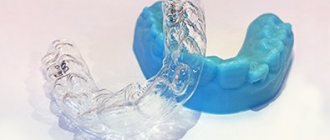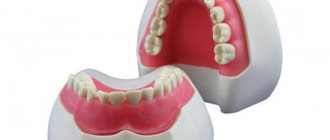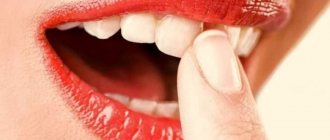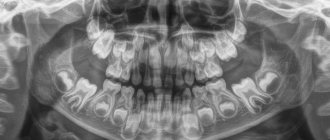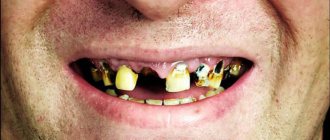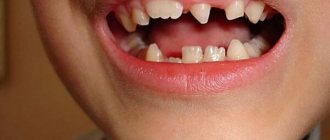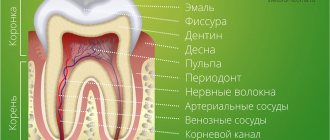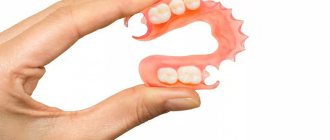“You urgently need to remove the 48th tooth!” - such a statement from the dentist can seriously puzzle the patient, because even from a school biology course everyone knows that there are only thirty-two teeth in the mouth. Where did this mysterious 48th come from, and what is with the strange numbering of teeth among dentists? Cunning doctors have invented a diagram of a person’s teeth with numbers that only they understand, and patients get confused in these numbers, trying to understand what they are talking about and where they suddenly got “extra” dental units from.
In fact, the teeth numbering scheme in dentistry is quite simple, clear and accessible - it was created in order to facilitate the “accounting” of dental units in patients and bring it to some uniform standards. After all, if every dentist starts counting dental units as he pleases, nothing good will definitely come of it. Especially if the patient subsequently gets an appointment with another doctor and he simply does not understand what tooth numbers are indicated in the medical record and what kind of treatment was ultimately carried out earlier.
How dentists count teeth: arrangement and numbering principles
Each dental unit has its own functions, depending on its structure and location on the jaw. Thus, incisors are designed for biting off pieces of food, canines help to hold hard food and “tear off” stubborn pieces, premolars are needed for primary processing, and dense “plump” molars are designed for thoroughly chewing and grinding food. The order of the teeth in the mouth, accordingly, will be as follows: on each jaw there are four incisors, two canines, four premolars (two on each side) and six molars (three on each side).
In dentistry, tooth numbers are assigned according to their location on the jaw and function. Since the incisors and molars are located symmetrically on the right and left, the count starts from the middle of the row, that is, from the central incisors and further to the right and left. If we divide this row into two halves and start counting on one of them, we get: two incisors (teeth numbers 1 and 2), a canine (3rd number), two premolars (4th and 5th), three molar (6th, 7th and 8th, the last one being the wisdom tooth). These are the names and numbers of teeth that are universally accepted in dentistry.
If you have a problem similar to that described in this article, be sure to contact our specialists. Don't diagnose yourself!
Why you should call us now:
- We will answer all your questions in 3 minutes
- Free consultation
- The average work experience of doctors is 12 years
- Convenient location of clinics
Single contact phone number: +7
Make an appointment
But if you simply say “sixth tooth,” then how can you understand whether it is upper or lower, and on which side of the jaw – left or right – it is located? To eliminate confusion in this matter, it is customary to designate a person’s teeth by numbers, indicating the segment of the jaw on which they are located. The segments are considered as follows: the upper right is the first and is indicated by a ten in front of the number of a particular tooth (for example, the 11th is the central right upper incisor, the 16th is the upper right molar, next immediately after the premolars, etc.), the upper left - twenty. Accordingly, the lower left is designated by thirty, and the lower right by the number 40. That is, the segments of the jaws are numbered clockwise, this makes it much easier to remember the order and, if necessary, count.
Thus, the notorious 48th number indicates the location of the wisdom teeth in the lower right segment of the jaw. And insisting on removing the 48th dental unit, the dentist simply indicates what number the wisdom tooth has in the lower right, and does not inform the patient about the supernumerary teeth that came from nowhere in the mouth.
Tooth numbering systems: ISO (FDI), universal, Zsigmondy-Palmer (+ visual illustrations)
There is probably no student of the Faculty of Dentistry who at one time would not have been confused by various tooth numbering systems. Where did they come from? For what? And how to convert tooth numbers from one system to another? We will answer the first two questions in text, and the illustrations given in this material will help you with the third.
What does the diagram of a child’s teeth look like with the numbers of each unit?
The pattern of baby teeth in children differs from the pattern with numbers in adults. Doctors specially designate milk teeth with different numbers so as not to confuse themselves and their patients: after all, a child who was treated for a milk bite in childhood will soon grow up and begin to go to the dentist for treatment of already permanent dental units. And if the same numbering is used in both cases, then there will be incredible confusion in the treatment history - but such a history in the dental record is often extremely important for the further competent and effective elimination of problems of the dental system.
Therefore, the numbering order for baby teeth in children is as follows: the serial number remains the same as in adults (1st, 2nd – incisors, 3rd – canine, etc.), but the segments of the jaws are designated by numbers 50 and 60 for the upper right and left segments and numbers 70 and 80 for the lower left and right, respectively. And when the dentist informs parents that their child has caries on the 82nd tooth, you don’t need to immediately imagine a baby shark with several rows of sharp baby teeth, we are only talking about the second lower right incisor. According to the counting scheme, permanent teeth in children are no different from the scheme of adult molars.
Signs of the imminent appearance of molars
You can determine when you should soon wait for the baby teeth to begin replacing with permanent teeth based on several signs:
- The gradual growth of the baby's jaws leads to increasing gaps between the teeth.
- The tooth begins to wobble. This is due to the fact that the already small root begins to gradually dissolve, causing the fixation of baby teeth to be significantly weakened.
- A fallen tooth indicates that the formed permanent one, which is about to appear, pushed it out.
- Swelling and redness may appear on the gums at the site of the eruption of a permanent tooth.
- Pain in the gums, where the permanent tooth erupts, increased temperature, and poor health of the child indicate problems have arisen, and it is necessary to see a doctor. The process of erupting molars should be painless.
International Viola system: a convenient diagram of the arrangement of a person’s teeth by numbers
The described method is very convenient and most common in dentistry. It has received international recognition and has been generally accepted among dentists since 1971, called the two-digit Viola system. The convenience of such a system lies primarily in the fact that there is no need to create a special map of a person’s teeth, the numbering is easily calculated in the mind and information about the condition of certain dental units of the patient can be easily conveyed in an oral conversation, by telephone or by e-mail.
However, many people, having read this far, may say: but our teeth were counted completely differently, and the map contains completely different designations! That’s right, because in addition to the Viola system, there are several other systems that can be used by dentists.
Reasons for creating a dental formula
Human teeth, despite their visual similarity, have certain differences. Each tooth is individual and designed to perform its function. Thanks to numbering in the dental field, examination of the patient's oral cavity is optimized to the maximum.
Clear and concise markings help to accurately record information in the patient's chart. In this case, the use of the same numbering system is observed. This is necessary so that the new doctor can decipher the medical history and past treatments that were performed by another dentist. Different dentists cannot use an individual calculation system, as this will change the patient's hospital history.
International two-digit Viola system
In practical dentistry, such designations are rarely used, and the teeth of a person’s jaws are simply numbered from incisors to molars (from 1 to 8).
International two-digit Viola circuit
The scheme was adopted by the World Health Organization in 1971 and is used throughout Europe [3]
All teeth are divided into 4 sectors (counterclockwise when viewed from the inside):
- The teeth of the upper jaw are on the right (respectively, the central incisor is 11, the second incisor is 12, the canine is 13, the first premolar is 14, the second premolar is 15, the first molar is 16, the second molar is 17, the third molar or wisdom tooth is 18).
- The teeth of the upper jaw are on the left (21, 22, 23, 24, 25, 26, 27, 28, similar to the right side) [4].
- Lower jaw teeth on the left (31, 32, 33, 34, 35, 36, 37, 38).
- Lower jaw teeth on the right (41, 42, 43, 44, 45, 46, 47, 48).
For children's teeth, a similar numbering is used from 51 to 85, or they are indicated in Latin numerals.
Haderup scheme
This scheme also uses the division of the jaws into segments, and individual numbers are assigned to the teeth. These numbers are calculated as in the international system - from the center of the jaw to its edge and have digital values from “1” to “8”. However, in this case, instead of the digital designation of segments, the signs “+” and “-” will be used. Here, a positive value indicates the upper jaw, and a negative value indicates the lower jaw. Showing the left and right sides of the jaws is very simple. You just need to place the desired sign to the left (for the left side) or to the right (for the right side) of the number that indicates the tooth. [3]
Haderup numbering scheme
| permanent teeth | |||||||||||||||
| top right | top left | ||||||||||||||
| 8+ | 7+ | 6+ | 5+ | 4+ | 3+ | 2+ | 1+ | +1 | +2 | +3 | +4 | +5 | +6 | +7 | +8 |
| 8− | 7− | 6− | 5− | 4− | 3− | 2− | 1− | −1 | −2 | −3 | −4 | −5 | −6 | −7 | −8 |
| bottom right | bottom left | ||||||||||||||
| baby teeth | |||||||||||||||
| top right | top left | ||||||||||||||
| 05+ | 04+ | 03+ | 02+ | 01+ | +01 | +02 | +03 | +04 | +05 | ||||||
| 05− | 04− | 03− | 02− | 01− | −01 | −02 | −03 | −04 | −05 | ||||||
| bottom right | bottom left | ||||||||||||||
| baby teeth (alternative system) | |||||||||||||||
| top right | top left | ||||||||||||||
| V+ | IV+ | III+ | II+ | I+ | +I | +II | +III | +IV | +V | ||||||
| V− | IV− | III− | II− | I− | −I | −II | −III | −IV | −V | ||||||
| bottom right | bottom left | ||||||||||||||
Zsigmondy-Palmer scheme
The system was first used in 1976. It is also called square-digital.
To indicate that a tooth belongs to any segment, a special icon is placed next to the number (in one of the four corners) - “corner”. It seems to indicate a piece of the crown, showing how it grows - down or up. [3]
Zahnschema nach Zsigmondy
| permanent teeth | |||||||||||||||
| top right | top left | ||||||||||||||
| 8 | 7 | 6 | 5 | 4 | 3 | 2 | 1 | 1 | 2 | 3 | 4 | 5 | 6 | 7 | 8 |
| 8 | 7 | 6 | 5 | 4 | 3 | 2 | 1 | 1 | 2 | 3 | 4 | 5 | 6 | 7 | 8 |
| bottom right | bottom left | ||||||||||||||
| baby teeth | |||||||||||||||
| top right | top left | ||||||||||||||
| V | IV | III | II | I | I | II | III | IV | V | ||||||
| V | IV | III | II | I | I | II | III | IV | V | ||||||
| bottom right | bottom left | ||||||||||||||
What other options exist for naming a person’s teeth by numbers?
There are three other systems common among dentists that can be used to designate and record dental units:
- A universal alphanumeric system developed by the American Dental Association.
- Zsigmondy-Palmer system. One of the oldest counting systems (it was created back in 1876), it is often used in their practice by maxillofacial surgeons and orthodontists.
- Haderup system.
All of them are convenient and easy to use in their own way, and in all such systems the arrangement of teeth by numbers in adults and children is indicated differently.
Alphanumeric system
It provides an indication of not only the number of the dental unit, but also its functional purpose. Thus, incisors are designated by the letter I, canines by the letter C, premolars by the letter P and molars by the letter M. As for the numbers, they indicate the serial number of a specific functional unit in the segment (whereas in other systems the functions of the dental unit are not taken into account, only its position is taken into account in a row). For example, if according to the Viola system the wisdom tooth is numbered 8, then according to the alphanumeric system it is also designated as M3, that is, the third molar in the segment. Additionally, digital segment designations are also used, which is why the serial number becomes two-digit. The same 48th tooth mentioned more than once with such a scheme will be designated as M43.
For milk teeth, lowercase (small) Latin letters are used in the recording, and instead of numbers, sometimes letter values from A to K are also indicated, counting dental units clockwise from the upper right incisor.
Zsigmondy-Palmer system
In old, and sometimes in new dental outpatient records, you can see a special plate for recording the condition of dental units, based on the Zsigmondy-Palmer square-numeric system. The order of growth of an adult’s teeth is indicated here by the familiar Arabic numerals from 1 to 8; for children, they use Roman numerals from I to V. The numbers of the jaw segments are not indicated here, the data is simply entered into the corresponding parts of the table diagram. The system is quite convenient and visual, but in an oral conversation it can cause difficulties when indicating a specific dental unit.
Other counting systems
It’s easier to represent the location of teeth by numbers - the diagram is called the 2-digit Viola system. It has been operating since 1971. Its advantage is the convenience of calculation without the need to map the series. But in international dental practice, other systems are also used: Haderup, Palmer-Zsigmondy (used by orthodontists and surgeons), alphanumeric (in the USA). Each of their schemes has its own system for counting teeth in children and adults.
Anatomical (group) formulas
The anatomical norm of the dentition for an adult is 28-32, and for a child 20. At the age of 4 years, complementary molars erupt for the first time, and the entire set should be replaced with primary ones.
For an adult, the anatomical formula of teeth (full set) can be presented: I4/4C2/2P4/4M6/6=32
If we consider the milk series, it looks like this: i4/4c2/2m4/4=20 A child’s premolars are formed only at the age of 9-12 years, and wisdom teeth may not erupt at all.
The development of teeth and their formula are important for parents, who can promptly identify potential problems. If deviations from the described norm are detected, it is recommended to immediately contact a pediatric specialist for diagnosis.
Types of teeth
The human dental system belongs to the heterodont type. According to the norm, there are 32 teeth, but their number can be 28. Each has its own purpose. Dental formulas help distribute molar processes into groups based on their shape, location, and purpose.
Such numbering greatly facilitates the work of specialists. For permanent and baby teeth, various conditional expressions (formulas) have been created, slightly similar in the systematics of construction.
Understanding a dentist is not so difficult; it is enough to understand the dental formula and remember its diagram.
Rows of dental crowns are arches located on the upper and lower jaws, consisting of:
- 4 incisors (2 lateral, 2 central);
- 2 fangs;
- 4 premolars;
- 6 molars (possibly 4).
If we talk about molars, their number can be four, which corresponds to the norm. Molar wisdom teeth are considered a defect and are removed. As dentists say, this is a relic of the past. For ancient people, they were indispensable for grinding hard food; the shape of the jaw allowed them to cut through without problems.
Video about dental anatomy:
Until the age of three or four, children have a limited number of teeth to twenty. Their eruption starts at about six months.
The functions performed are identical to the permanent ones, while the teeth differ in their characteristic features:
- they are much smaller in size, have a delicate, bluish tint;
- dentin is not so developed, and the pulp is noticeably enlarged;
- the content of mineral compounds in enamel is much less.
To calculate the required number of teeth in children of different ages, a separate formula has been created:
N – required number of teeth n – child’s age in months
For example, 14 - 4 = 10 - in a year and two months the child will have 10 teeth. This system has a significant drawback - it has a limited period of use; after the child reaches two years of age, it is no longer suitable.
Children's arches number ten teeth:
- 4 incisors – 2 lateral, 2 central;
- 2 fangs;
- 4 premolars.
When is it necessary to prepare a hole for implantation?
If the bone volume is insufficient for implantation, the implantation operation will not be possible, so preliminary preparation is required. It is also recommended:
- To eliminate the risk of injury to the maxillary sinuses.
- When planning orthodontic treatment.
- When it is impossible to stabilize the implant in the tooth socket after removal.
- With age-related changes, bone tissue undergoes anatomical and physiological changes over time.
- To secure and extend the service life of any dental implant.
The material used is a synthetic biocompatible mass in granules, barrier membranes that are removed independently as new bone grows, or a connective tissue graft.
Indications and contraindications
Indications for the procedure:
– To prevent bone loss. – To eliminate defects associated with periodontal disease. – Creation of an optimal contour of bone and soft tissue to preserve the anatomical features of the area. – To ensure a good aesthetic result.
There are contraindications:
– Acute infectious diseases of the nasopharynx and oral cavity. – Oncological diseases. – Pregnancy and breastfeeding. – In immunodeficiency conditions. – State of acute pain after removal.
What is the procedure?
When a tooth is removed, the alveolar bone begins to decrease in size due to a decrease in load, cessation of blood supply and metabolic processes. Both height and thickness change. To preserve the volume of bone tissue and subsequent successful implantation, the hole is filled with a special osteogenic composition. It creates a frame and prevents further bone loss. Preparing the hole after tooth extraction before implantation is most relevant for the upper jaw, which includes air cavities. In this case, the frontal parts are especially important due to their aesthetic significance.
How is the socket prepared for implantation?
The entire procedure takes place under anesthesia, so the patient will not feel pain or discomfort. It is important for the patient to choose effective anesthetic drugs that do not cause allergies and eliminate all pain. Therefore, when creating a treatment plan, pay more attention to preparation and diagnosis. During the procedure, the implantologist will perform the following actions:
- Treat the surgical site with an antiseptic.
- Fill the hole with a bone-forming compound.
- Cover with a special hypoallergenic membrane.
- Fixes the surgical surface by tensioning the free edges of the connective tissue.
- He will put stitches.
